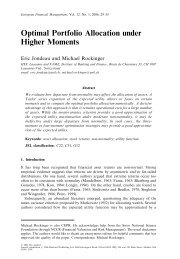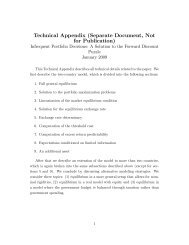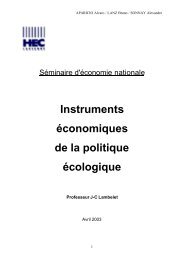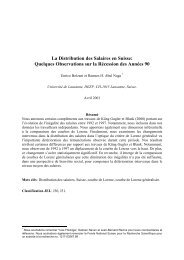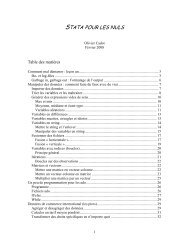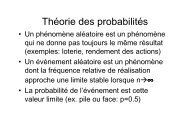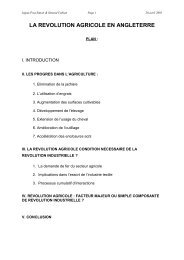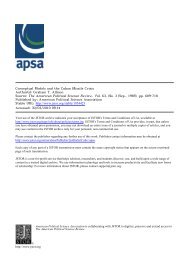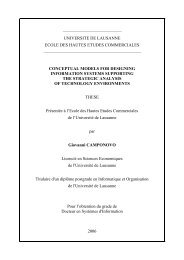The Business Model Ontology - a proposition in a design ... - HEC
The Business Model Ontology - a proposition in a design ... - HEC
The Business Model Ontology - a proposition in a design ... - HEC
Create successful ePaper yourself
Turn your PDF publications into a flip-book with our unique Google optimized e-Paper software.
<strong>The</strong> <strong>Bus<strong>in</strong>ess</strong> <strong>Model</strong> <strong>Ontology</strong> - a <strong>proposition</strong> <strong>in</strong> a <strong>design</strong> science approach<br />
horizontal <strong>in</strong>tegration <strong>in</strong> the value cha<strong>in</strong>. F<strong>in</strong>ally, journey models provoke most change and take a<br />
company to a complete new bus<strong>in</strong>ess model.<br />
Journey model<br />
Extension model<br />
Renewal model<br />
Realization model<br />
No bus<strong>in</strong>ess model<br />
change<br />
<strong>Bus<strong>in</strong>ess</strong> model<br />
change<br />
Degree to which<br />
core logic<br />
changes<br />
Figure 20: Change <strong>Model</strong>s (L<strong>in</strong>der and Cantrell 2000)<br />
Tapscott, Ticoll et al. (2000) propose a change methodology <strong>in</strong> six steps towards creat<strong>in</strong>g a b-web<br />
company (cf. Figure 15 and Table 4). <strong>The</strong> first step consists of describ<strong>in</strong>g the current value <strong>proposition</strong><br />
by def<strong>in</strong><strong>in</strong>g end-customers, offer<strong>in</strong>gs, customer value and the value <strong>proposition</strong>’s strengths and<br />
weaknesses from a customer’s perspective. <strong>The</strong> second step consists of disaggregat<strong>in</strong>g and identify<strong>in</strong>g<br />
the entities that contribute to the total value-creation system. <strong>The</strong> follow<strong>in</strong>g step envisions b-web<br />
enable value. In other words, planners must step outside their day-to-day mental models to develop<br />
creative and discont<strong>in</strong>uous views of do<strong>in</strong>g bus<strong>in</strong>ess. This means ask<strong>in</strong>g what new bus<strong>in</strong>ess models –<br />
ways of creat<strong>in</strong>g, sett<strong>in</strong>g, and deliver<strong>in</strong>g value and facilitat<strong>in</strong>g relationships with customers, suppliers,<br />
and partners – could be envisaged. In the fourth step the company must reaggregate. This step entails<br />
repopulat<strong>in</strong>g the categories of value contributors and assign<strong>in</strong>g contributions to the various classes of<br />
participants. <strong>The</strong> fifth step consists of prepar<strong>in</strong>g a value map, which is a graphical depiction of how a<br />
b-web operates. It identifies the participants, such as strategic partners, suppliers and customers and<br />
their exchanges of value. <strong>The</strong> last step consists of do<strong>in</strong>g the b-web mix, which means consider<strong>in</strong>g how<br />
each type and subtype might enhance customer value, provide competitive differentiation and<br />
advantage and reduce costs for the participants.<br />
In his e 3 -value methodology Gordijn (2002) outl<strong>in</strong>es a change methodology based on value model<br />
deconstruction and reconstruction, which is ma<strong>in</strong>ly <strong>in</strong>spired by Tapscott, Ticoll et al. (2000) Evans<br />
and Wurster (2000) and Timmers (1999). He splits the process <strong>in</strong>to two questions, namely, which<br />
value add<strong>in</strong>g activities exist, and which actors are will<strong>in</strong>g to perform these activities.<br />
Petrovic, Kittl et al. (2001) specify that the improvement and change of a real world bus<strong>in</strong>ess model is<br />
related to the ability to change a manager’s mental model. Accord<strong>in</strong>g to them, people often talk about<br />
reduc<strong>in</strong>g time and costs via automat<strong>in</strong>g or re<strong>design</strong><strong>in</strong>g processes when really they want to improve<br />
their bus<strong>in</strong>ess model. To change this Petrovic, Kittl et al. <strong>in</strong>troduce double-loop learn<strong>in</strong>g to explicit<br />
mental models through a systemic bus<strong>in</strong>ess model concept <strong>in</strong> order to provide a holistic, broad, longterm<br />
and dynamic view to help re<strong>design</strong> bus<strong>in</strong>ess models.<br />
Papakiriakopoulos and Poulymenakou (2001) propose a transformation method for construct<strong>in</strong>g e-<br />
bus<strong>in</strong>ess models based on their analytical framework outl<strong>in</strong>ed <strong>in</strong> section 3.1.3.1. <strong>The</strong> method <strong>in</strong>cludes<br />
4 steps, rang<strong>in</strong>g from the identification of players, over highlight<strong>in</strong>g the value flows and identify<strong>in</strong>g<br />
key competitive drivers to construct<strong>in</strong>g a feedback cha<strong>in</strong>. Thus, the first step consists of def<strong>in</strong><strong>in</strong>g the<br />
context and the scope of the bus<strong>in</strong>ess model. This means identify<strong>in</strong>g the list of stakeholders and<br />
describ<strong>in</strong>g their strategy. <strong>The</strong> second step consists of draw<strong>in</strong>g the relationships and flows between the<br />
actors <strong>in</strong> order to capture the value cha<strong>in</strong> concepts. Papakiriakopoulos and Poulymenakou recognize<br />
two ma<strong>in</strong> flows, which are the f<strong>in</strong>ancial flows and the communication flows. <strong>The</strong> next step of this<br />
methodology is about identify<strong>in</strong>g the nature of competition <strong>in</strong> the marketplace. <strong>The</strong> fourth and f<strong>in</strong>al<br />
step of the method aims at construct<strong>in</strong>g a so called "feedback cha<strong>in</strong>". <strong>The</strong> objective of the feedback<br />
cha<strong>in</strong> is to exam<strong>in</strong>e and collect all the <strong>in</strong>formation resources that could help and empower some<br />
37




